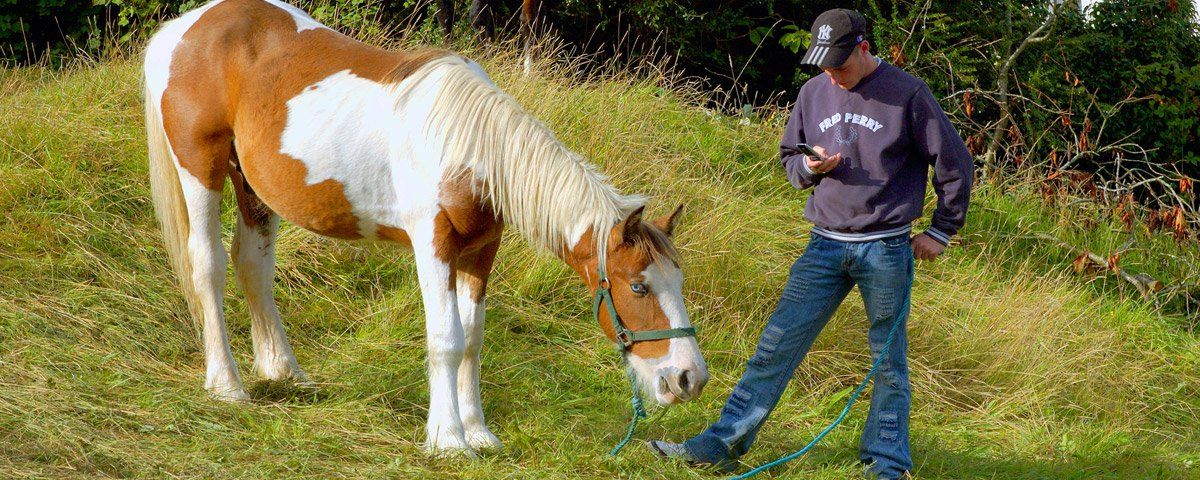The Lammas Fair, or as Mr John McAuley wrote in his famous song ‘ the Oul' Lammas Fair’, takes place on the last Monday and Tuesday in August. The fair is famed for having an 'unbroken history' over the past 300 years, though this was broken during the imposed covid lockdown. The origins of the fair go back to the myth and legends of Ireland, the name Lammas originates from the 'Feast of Lughnasadh' or Lugh (Lu) and comes from one of the great legends of Ireland. One interpretation and there are as many as there are ways of spelling the name, is as follows:- Lugh was a Sun God who had a mortal foster mother called Tailtiu, she was the queen or princess in the Firbolgs.
The Firbolgs (Men of Bags) were early inhabitants of Ireland and are said to have come from the east and settled in Iberia, the dominant race in that country forced them into servitude where they had to carry soil from the fertile plains to the higher ground. To do this they devised leather bags and became known as the ‘men of bags’ (Firbolgs). Eventually they became tired of slavery and fled in coracles (boats) made from leather, they sailed and landed in Ireland. They lived here until Ireland was invaded by the people of Dana (Tuatha de Danna) who established themselves as rulers.
The Dana forced Queen Tailtiu and her people to clear a large area of woodland for the planting of grain and she died of exhaustion in the process. She was buried under a great mound which became know as the ‘Hill of Tailtiu’ and Lugh instructed that each year a festival be held to commemorate his foster mother’s, instructing that the fair should hold games and feasting on the first fruits of the harvest. We find references in Ireland to the ‘Tailthiu Games’ and the ‘Games of Lugh’. Gillaspick, the son of Colla MacDonnell (Kenbane Castley) was killed fighting a bull at ‘games’ in Ballycastle and these games were more than likely taking part at the Lammas Fair or the 'Games of Lugh'. The celebration of ‘Lugh’ was known for games of athletic abilities.
The tradition of the festival of Lugh is expressed through many cultures, we find the Lammas in Saxon times, in the West Indies and today we can find Lammas Fairs being celebrated throughout the world. With the arrival of Christianity to Ireland and its dominance as a faith, we find the festival of Lugh changing and adopting more Christian symbolism, for example, loaves of bread baked from the first harvest grain are placed on the church altar. The ‘Christianised’ name for the festival of Lugh becomes Lammas which means ‘loaf mass’. In medieval times we find references to the Lammastide, when craft fairs and pageants would be held. It is also thought to have been the time when Saint Catherine was celebrated, she gave rise to the term‘ The Catherine Wheel’. This came from Pagan worship when a wagon wheel would be tarred, taken to the top of a hill, set on fire and rolled down, symbolizing the decline of the Sun God ( Autumn Equinox).
It is well known that the Catholic Church was never too comfortable with Saint Catherine, feeling that she was too much on the side of myth, mystics and the old beliefs, they changed her day of celebration frequently and also at one point tried to remove her saintly title. Today’s Lammas is a time of stalls, buying and selling, traditional music and horse-trading, a local tradition exists of eating yellow candy called ‘Yellow Man’ and eating ‘Dulse’, a reddish brown seaweed of the variety ‘Palmaria palmata’ which has been eaten and used in medicine for centuries in Ireland. The ‘Oul Lammas Fair’ attracts people in their thousands from all over the world and is well worth a visit if you are in the vicinity.





